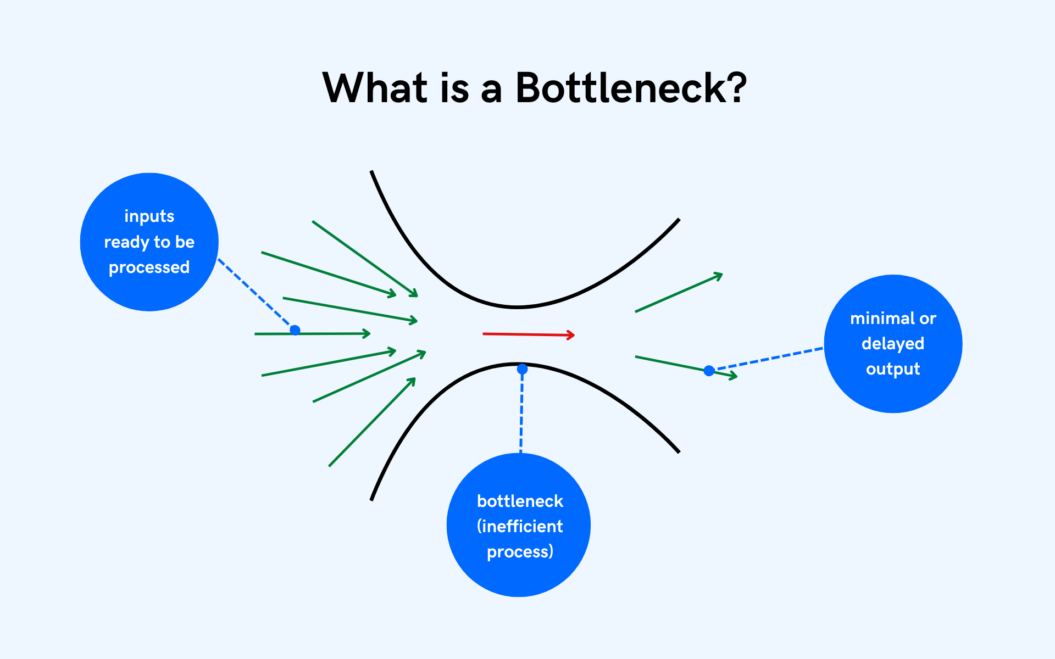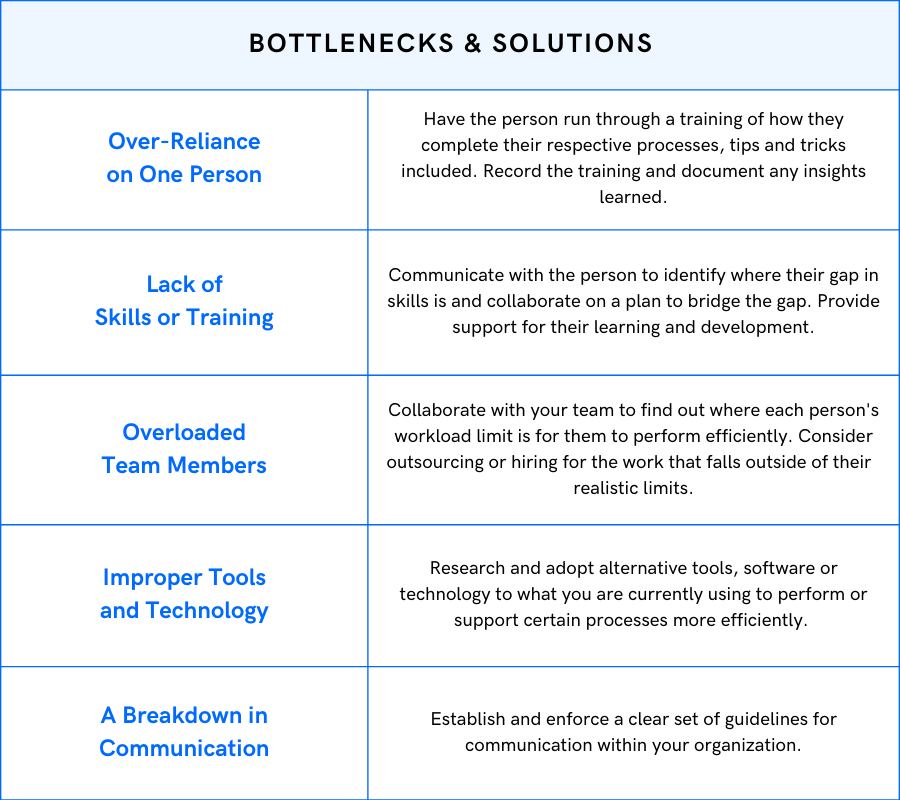There are only so many hours in a day, and a video business owner knows that better than anybody.
But, what if we told you that there’s a way to create more hours in your day while getting the same amount of work done?
And, while we’re big fans of delegating, this post is about something else: removing the inefficiencies from your membership business, for good.
Let’s unpack exactly what bottlenecks are, why they’re a problem, and how you can fix them.
Bottlenecks: What They Are & How to Get Rid of Them
A membership business is like a machine: many different moving parts that work together to support an end goal.
But, what happens when one part gets a bit stuck, or even breaks? The machine slows down, gets wobbly, or – worst case scenario – it stops working altogether.
When it comes to your membership, those sticky parts are referred to as bottlenecks, which are the points in a process where progress seems to slow down dramatically, or even come to a temporary stop.

Bottlenecks might seem like a problem to leave for another day, but they can actually hold back the growth of your membership, waste time and resources, and lead to burnout for you and your team.
Before we get into how to identify and remove these bottlenecks from your business, it can be helpful to know what to look out for. The 5 most common bottlenecks you might encounter in your membership business are:
- Over-Reliance on One Person: when your business relies too heavily on one person’s capabilities or knowledge. This happens when only one person in the organization knows exactly how to perform a specific process.
- Lack of Skills or Training: when one or more team members lack the specific skills and knowledge needed to perform their processes efficiently. This is common for people whose roles require a lot of cross-functional multitasking.
- Overloaded Team Members: when one or more team members have too many responsibilities to perform them all timeously. This will happen when the goals and outputs of an organization grows, but its team remains the same size.
- Improper Tools and Technology: when the tools, software and technology used within a process are inefficient or have been outgrown. This can happen if the wrong tools are being used, and if there are too many or too few tools being used.
- A Breakdown in Communication: when important information is consistently not communicated between team members. This often happens when there is a lack of guidelines or expectations for communication within an organization.
It’s important to note that key-person dependency grabbed the number 1 spot in that list for a reason: creators are accustomed to wearing (too) many hats.
In our recent interview with six-figure creator, Modern Millie, she shared a conclusion that rings true for many, “The biggest bottleneck I’ve noticed is me.”
Like thousands of creators before her, Millie took responsibility for nearly all of the moving parts in her business. It’s a common trend among creatives who have a lot to do, and limited resources to do it with.
And it can work well for a period of time, like it did for Millie.
Until she was forced to step away from work for 3 months. At the time, her business was set up to rely almost entirely on her showing up every day, so there were no systems in place to run things while she was out.
The result? A significant drop in Millie’s revenue.
If you suspect that you could also be overly relied on, keep a close eye on how many processes are owned solely by you when searching for bottlenecks.
Now, let’s take a look at how to identify and remove those bottlenecks to keep your membership business running like a well-oiled machine.
How to Check for Bottlenecks
To go about removing bottlenecks from your membership business, you need to know where they are, and why they’re happening.
Now, an easy way to approach your search for those bottlenecks would be to break down the processes that fall under each system or ‘department’ of your business.
For example, the list of processes within a content production system might look something like this:
- Planning
- Scriptwriting
- Filming
- Editing
- Thumbnail design
It’s a good idea to jot down the name of the person who is responsible for each process so that, at a glance, you know who you need to speak to about what.
It can also be a helpful resource to see if somebody seems to have too much on their plate, whether they’re in-house, outsourced, or you (and your many hats).
Once you have all of your systems and their respective processes mapped out, you’ll need to prioritize which system or process you address first.
The way you prioritize this is up to you. You could start with the processes that you already know take the most amount of time to produce an output. Or, you could start with processes that produce the most valuable outputs.
Once your order of operations is set up, the next step is to look for signs of a bottleneck in each process.
For example, let’s say that there’s consistently a 2 day gap between when a video has been edited, and when feedback is provided on those edits.
That means that progress for the video editing process comes to a full stop for 2 days without good reason. And there’s your bottleneck.
Bottlenecks will present in different ways across all of the systems and processes in your business, but you’ll always be looking for the same thing: where in a process does progress slow down unnecessarily, or stop completely?
If you’ve identified one or more bottlenecks in your business, it’s time to start analyzing to get to the root cause. It could boil down to factors like poorly setup processes, overloaded team members, or a lack of communication.
Whatever the cause, who better to crack the case than the person who owns that process?
Whether it’s you or somebody else on your team, set aside some time to ask questions and note down some answers. The end goal is to know where the inefficiency begins and ends, and what is causing it.
How to Fix Your Bottlenecks
Now that you’re done identifying and analyzing, it’s time to remove those pesky bottlenecks (with a plan, of course).
One way to assemble your plan of action is to compare the resources you’re putting into each solution with the value of what you’ll get out of it. Prioritize the solutions that offer the biggest return on investment, and work your way down from there.
Once you’ve developed your plan to remove the bottlenecks, it’s time to implement it!
Some bottlenecks might demand bigger investments, like outsourcing and hiring, or adopting new technology and software. Other solutions could be more straightforward, like redesigning or updating a process.
Based on the 5 most common bottlenecks we mentioned earlier, here’s a simple cheat sheet to help guide your next steps:

Throughout this period, it’s important to keep your finger on the pulse of each process. Monitor the progress that’s being made, and adjust your solution if needed.
Now, once things are running smoothly, how can you make sure your new solutions stick?
How to Prevent Bottlenecks
In order to prevent bottlenecks from returning, it’s important to review and refine your plan.
Start by analyzing the results of all of the changes you’ve made, and document everything from the good to the bad. Some processes might be running perfectly as expected, and others might require a bit more TLC before it’s totally bottleneck-free.
Remember to factor in that with changes, big or small, it might take some time for you and your team to get into a new rhythm with these new or updated processes.
Which brings us to the next step: regroup and ask for more feedback from your team members and freelancers.
Make sure that they feel comfortable and satisfied with how their respective processes are running. To help with this, keep your lines of communication open and encourage your team to keep you updated if they feel that a bottleneck is re-emerging.
Once the heavy-lifting is done, it’s all about maintenance. Oiling the machine, if you will.
Look out for opportunities to further optimize important processes, and make sure that they’re evolving as needed as your membership and your team continue to grow.
Wrapping Up…
Bottlenecks are a common problem for nearly every membership business. They can stunt business growth, waste time and resources, and lead to burnout for you and your team.
To identify if these bottlenecks exist in your business, it’s as straightforward as making a list of all of your processes, prioritizing them by importance and impact, and analyzing each process to see if and where the slow-down takes place.
When you have all of your identified bottlenecks mapped out, and you understand their root cause, you can tackle them one-by-one by implementing their corresponding solution.
You can then analyze the results of the changes you’ve made, and keep your finger on the pulse to pick up on any possible re-emerging bottlenecks.
From there, once you know exactly what to look for and how to fix it, it’s all about maintenance.





